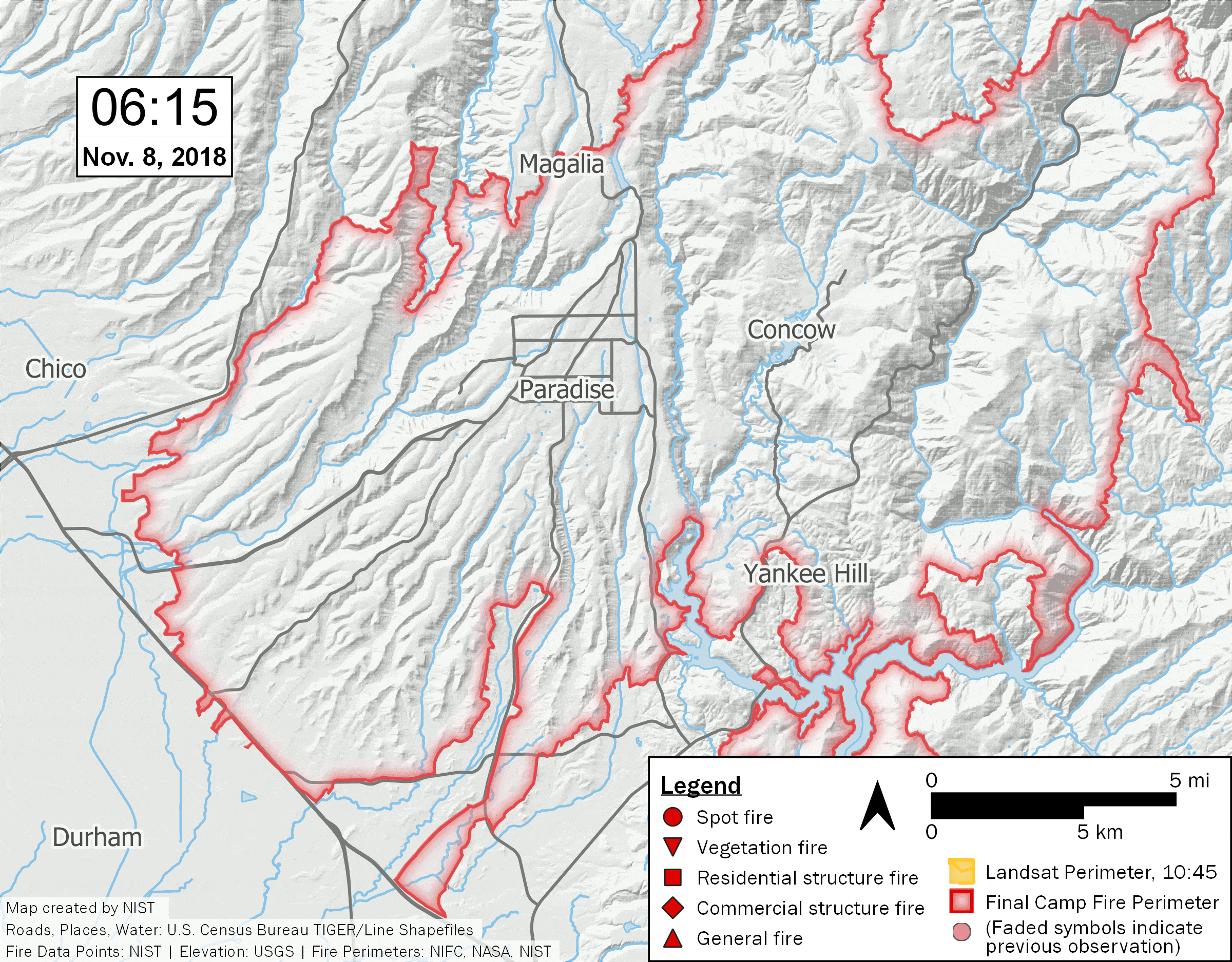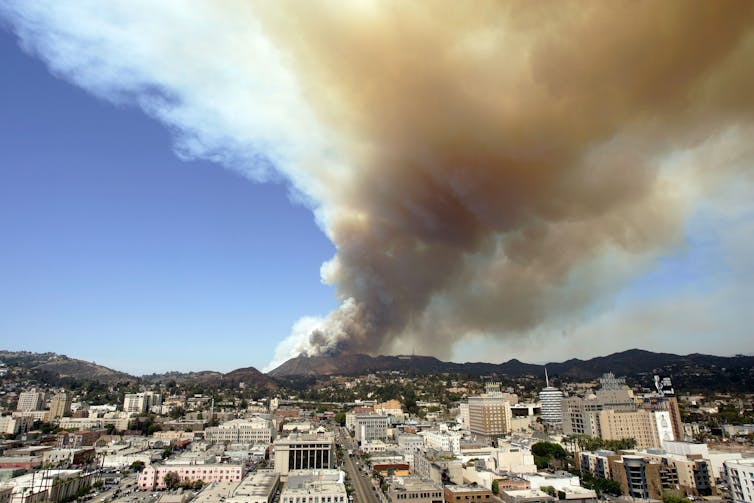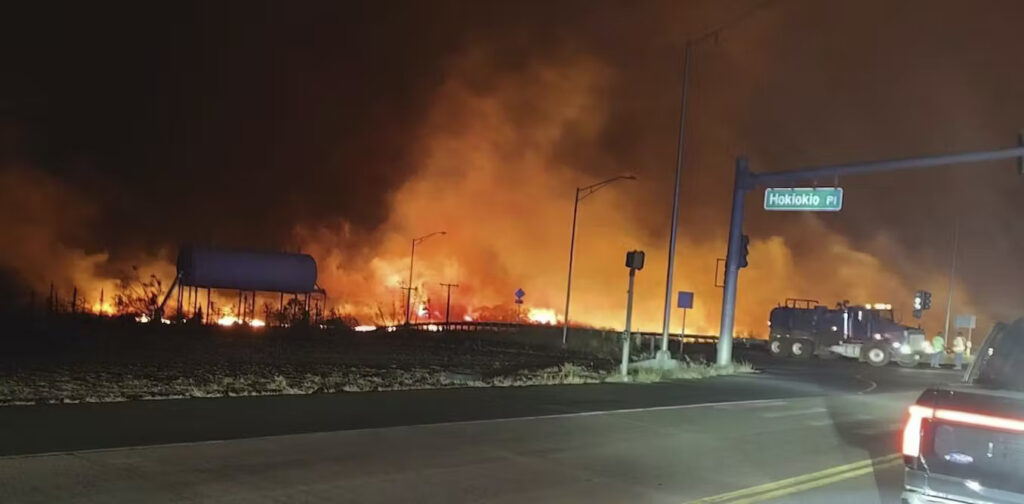Hawaii: Maui’s Deadly Wildfires Burn Through Lahaina
ENVIRONMENT, 14 Aug 2023
Mojtaba Sadegh | The Conversation - TRANSCEND Media Service
It’s a Reminder of the Growing Risk to Communities That Once Seemed Safe
8 Aug 2023 – Wildfires, pushed by powerful winds, raced through Lahaina, Hawaii, on Aug. 8 and 9, 2023, leaving a charred and smoldering landscape across the tourist town of about 13,000 residents that was once the capital of the Kingdom of Hawaii. At least 67 people died, Maui County officials said. Others were rescued by the U.S. Coast Guard after going into the ocean to escape the flames.
Dry grasses and strong winds, influenced by Hurricane Dora passing far to the south, heightened the risk as wildfires burned both in Maui’s tourist-filled west coast and farther inland and on the Big Island of Hawaii.
Most fires in the U.S. are suppressed before they have a chance to threaten communities, but the winds were too strong to send helicopters into the sky to help contain Maui’s fires on the first day, leaving firefighters to battle the blazes from the ground.
Lt. Gov. Sylvia Luke issued an emergency declaration, activating the National Guard to help, and urged travelers to stay away.
Video shared by Maui Now shows the fires and strong winds:
Fires have become an increasing risk in many areas of the U.S. that people once considered safe.
Over the past two decades, a staggering 21.8 million Americans found themselves living within 3 miles (5 kilometers) of a large wildfire. Nearly 600,000 of them were directly exposed to the fire, with their homes inside the wildfire perimeter. That number – people directly exposed to wildfires – more than doubled from 2000 to 2019, my team’s recent research shows.
But while commentators often blame the rising risk on homebuilders pushing deeper into the wildland areas, we found that the population growth in these high-risk areas explained only a small part of the increase in the number of people who were exposed to wildfires.
Instead, three-quarters of this trend was driven by intense fires growing out of control and encroaching on existing communities.
That knowledge has implications for how communities prepare to fight wildfires in the future, how they respond to population growth and whether policy changes such as increasing insurance premiums to reduce losses will be effective.
Lines of flames move quickly through the hills in Maui the night of Aug. 8, 2023.
Video by Clint Hansen:
What climate change has to do with wildfires
Hot, dry weather pulls moisture from plants and soil, leaving dry fuel that can easily burn. On a windy day, a spark from a power line, campfire or lightning can start a wildfire that quickly spreads.
Recent research on California’s fires found that almost all of the increase in that state’s burned area in recent decades was due to anthropogenic climate change – meaning climate change caused by human activities.
Our new research looked beyond just the area burned and asked: Where were people exposed to wildfires, and why?
Where wildfire exposure was highest
I am a climate scientist who studies the wildfire-climate relationship and its socioenvironmental impacts. Colleagues and I analyzed the boundaries of more than 15,000 large wildfires across the lower 48 states and annual population distribution data to estimate the number of people exposed to those fires.
If you picture wildfire photos taken from a plane, fires generally burn in patches rather than as a wall of flame. Pockets of homes within the fire boundary survive, but many also burn.

The 2018 fire that destroyed Paradise, Calif., began as a small vegetation fire that ignited new fires as the wind blew its embers. NIST
While the population has grown in the wildland-urban interface – the region where houses intermingle with forests, shrublands or grasslands – we found that population growth accounted for only about one-quarter of the increase in the number of humans directly exposed to wildfires across the lower 48 states from 2000 to 2019.
Three-quarters of the 125% increase in exposure was due to fires increasingly encroaching on existing communities. The total burned area increased only 38%, but the locations of intense fires near towns and cities put lives at risk.
In California, the state with the most people exposed to fires, several wildfire catastrophes hit communities that had existed long before 2000. Almost all these catastrophes occurred during dry, hot, windy conditions that have become increasingly frequent because of climate change.

Hector Mata/AFP via Getty Images
What communities can do to lower the risk
Studies have shown that even in conservative scenarios, the amount of area that burns in Western wildfires is projected to grow in the next few decades.
How much these fires grow and how intense they become depends largely on warming trends. Reducing greenhouse gas emissions will help slow warming. But communities will also have to adapt to more wildfires. Developing community-level wildfire response plans, reducing human ignitions of wildfires and improving zoning and building codes can help prevent fires from becoming destructive.
______________________________________________
 Mojtaba Sadegh is Associate Professor of Civil Engineering at the Boise State University.
Mojtaba Sadegh is Associate Professor of Civil Engineering at the Boise State University.
Go to Original – theconversation.com
Tags: Climate Change, Environment, Forest fires, Global warming, Hawaii, Lahaina, Maui, Wild fires
DISCLAIMER: The statements, views and opinions expressed in pieces republished here are solely those of the authors and do not necessarily represent those of TMS. In accordance with title 17 U.S.C. section 107, this material is distributed without profit to those who have expressed a prior interest in receiving the included information for research and educational purposes. TMS has no affiliation whatsoever with the originator of this article nor is TMS endorsed or sponsored by the originator. “GO TO ORIGINAL” links are provided as a convenience to our readers and allow for verification of authenticity. However, as originating pages are often updated by their originating host sites, the versions posted may not match the versions our readers view when clicking the “GO TO ORIGINAL” links. This site contains copyrighted material the use of which has not always been specifically authorized by the copyright owner. We are making such material available in our efforts to advance understanding of environmental, political, human rights, economic, democracy, scientific, and social justice issues, etc. We believe this constitutes a ‘fair use’ of any such copyrighted material as provided for in section 107 of the US Copyright Law. In accordance with Title 17 U.S.C. Section 107, the material on this site is distributed without profit to those who have expressed a prior interest in receiving the included information for research and educational purposes. For more information go to: http://www.law.cornell.edu/uscode/17/107.shtml. If you wish to use copyrighted material from this site for purposes of your own that go beyond ‘fair use’, you must obtain permission from the copyright owner.
